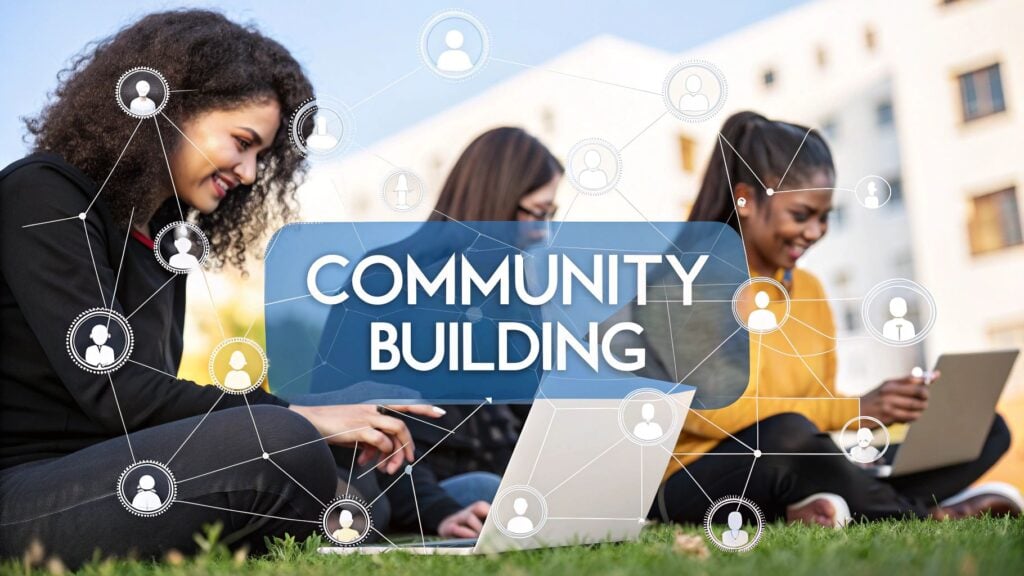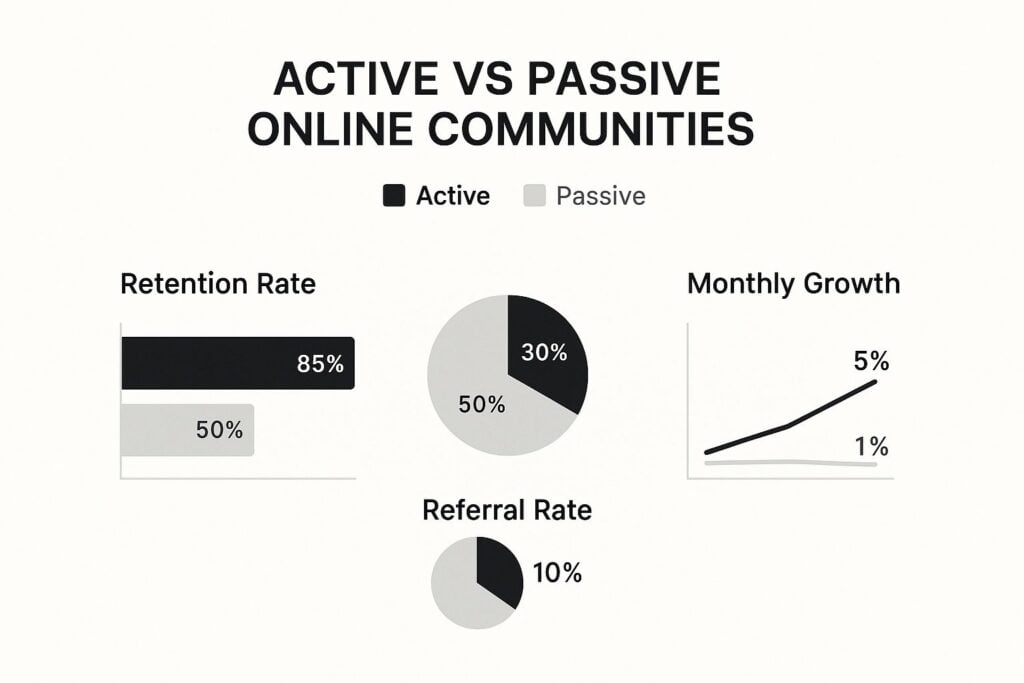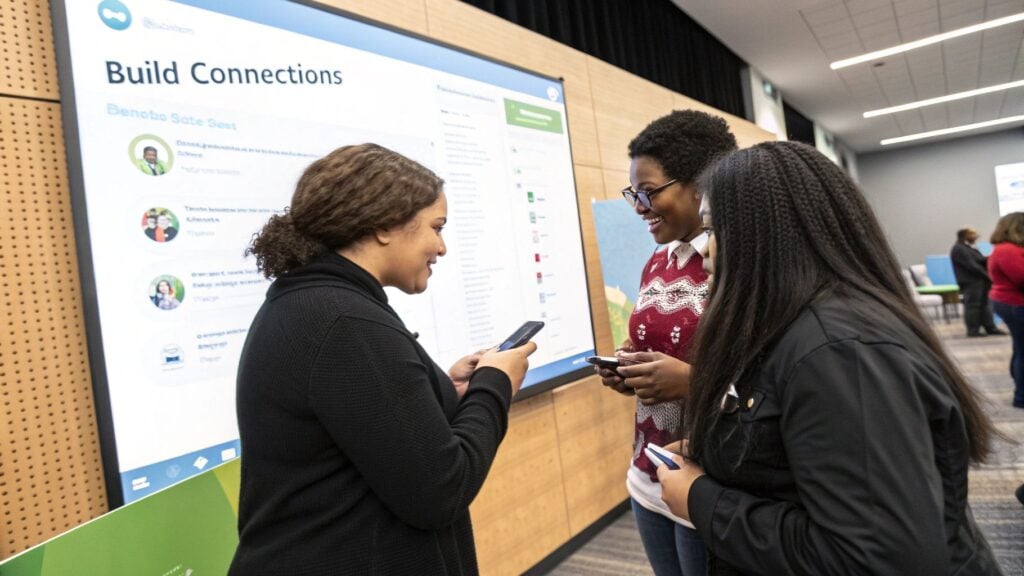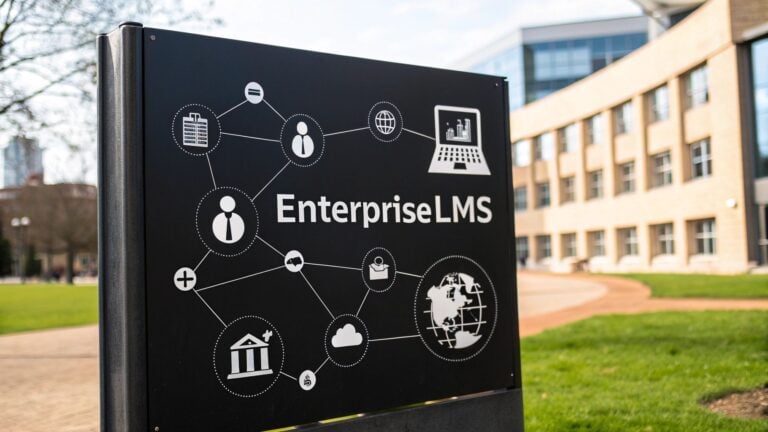How to Build an Online Community: Tips for Success

Building an online community really comes down to two things: a clear purpose and the right people. Before you choose a platform or hit send on that first invite, you have to figure out why this group exists and who it’s for. If you can nail that, you’ll spark real engagement.
Defining Your Community’s Purpose and People
It’s easy to get excited about platform features or content ideas, but I’d recommend holding off for just a bit. I’ve seen so many promising communities fizzle out because the founders skipped this crucial groundwork. A powerful community is a group of people bound by a shared mission.
Find Your Core Mission
Your mission is like a compass for every decision you’ll make. It’s what draws people in and keeps them coming back. You have to ask yourself: what unique value can I deliver that no one else offers?
Imagine you’re running an online course. Saying the community is “for course discussion” is a little flat. Instead, you could frame it as “a collaborative space where students tackle projects together, troubleshoot real challenges, and cheer each other on.” That simple shift puts your learners and their journey at the heart of everything. For more ideas, you can check out how to build community in an online course.
When you’re sketching out your identity, it helps to look at how others have done it. I suggest exploring some inspiring brand story examples to see how others have woven their purpose into every interaction.
Communities built on shared identity and mutual value attract members and turn them into advocates.
Identify Your Ideal Members
Once your “why” is crystal clear, it’s time to zoom in on “who.” Who are the people you want in this circle? Creating a simple member persona will guide everything from your welcome messages to the topics you talk about.
Go beyond just age and location. I try to dive into what truly drives them:
- What are their top goals around your community’s theme?
- What obstacles or frustrations keep them up at night?
- What kind of connections or support are they looking for?
- How do they prefer to communicate (live chat, forums, video)?
Answering these questions lets you tailor every touchpoint. It helps you build a space that feels like it was custom-made for them.
Strategic planning here pays off in a big way. In fact, 86% of marketers say branded online communities enhance their core business operations. Yet nearly half admit their groups lack clear, measurable goals. Getting your mission and member profile right from the start puts you well ahead of the pack.
Community Platform Feature Comparison
Choosing the right platform is critical. Here’s a quick rundown of popular options to help you decide:
| Platform Type | Best For | Key Features | Ownership & Control |
|---|---|---|---|
| Hosted Community | Fast setup, low maintenance | Built-in moderation, analytics, integrations | Platform rules apply, limited custom branding |
| Self-Hosted Forum | Full customization | Total design control, plugin ecosystem, data ownership | You manage hosting, updates, security |
| Social Media Group | Broad discovery | Familiar UX, mobile apps, notifications | Platform algorithms dictate reach |
| All-in-One Platforms | Courses + community | Unified billing, course tools, member management | Vendor lock-in risk, integrated UX |
This side-by-side snapshot should steer you toward a platform that aligns with your technical comfort level, budget, and growth plans.
The next step? Dive into setup, invite those first members, and watch connections form. But remember, this foundation you’ve built, your mission, member personas, and chosen platform, is what keeps a community thriving long after launch.

Active, purpose-driven communities flourish, with higher retention and referral rates. This initial planning is your first big step on the journey to building a space where people genuinely belong.
Creating a Welcoming and Engaging Space
You’ve figured out your community’s purpose and who it’s for. Now comes the fun part: building the actual space. A great online community feels alive from the moment someone joins. It creates an atmosphere where people are genuinely excited to jump in. This all starts with a fantastic first impression.
The onboarding experience is your one chance to make new members feel seen and valued. A generic “welcome to the group” notification just won’t cut it. To spark those crucial initial connections, you have to be more intentional.
Think about what happens when you walk into a friendly party. Someone greets you at the door, introduces you to a few people, and maybe offers you a drink. Your community’s welcome should feel just like that, but online.
Crafting a Memorable Onboarding Experience
A thoughtful welcome can be the difference between a member who logs in once and disappears, and one who becomes a regular, valuable contributor. It sets the tone and shows people you’ve put real care into building this space for them.
Here are a few simple but incredibly effective ideas to get new members talking right away:
- Send a Personal Welcome DM: Instead of a canned message, send a quick, personal note. Mention something specific from their application or profile if you can. It takes 30 seconds but shows you’re actually paying attention.
- Create a Fun Introductions Thread: Start a dedicated thread like “#SayHello” or “#Introductions.” Don’t just ask for their job title. Encourage people to share something interesting, like their favorite hobby or the last great book they read.
- Offer a Simple First Task: Give new members an easy win. Ask them to vote on a poll, answer a simple question, or share a photo related to your community’s theme. This lowers the barrier to that all-important first act of participation.
These small touches do wonders to break the ice. They make your community feel less like a faceless forum and more like a room full of interesting people. When you’re looking for the right home for these conversations, exploring a purpose-built tool like the Discourse community platform can give you the features you need to manage these interactions without the headache.
Sparking Genuine and Consistent Engagement
A warm welcome is just the beginning. The real magic of a community comes from consistent, meaningful engagement. You need rituals and content that keep people coming back for more.
The key is to move beyond just broadcasting information and start hosting real conversations. You want to create content that invites a response and makes your members the stars of the show.
Here are some content ideas that I’ve found reliably spark conversation:
- Weekly Q&A Sessions: Host a weekly “Ask Me Anything” with an expert, or even with yourself. This creates a predictable and valuable reason for members to log in and participate.
- Member Spotlights: Feature a different member each week. Share their story, their wins, and what they’re working on. It’s a powerful way to build connections and make people feel celebrated.
- Collaborative Challenges: Run a simple weekly or monthly challenge. If you have a fitness community, it could be a “plank-a-day” challenge. For a writing group, a “500 words a day” challenge works wonders.
Building a community is all about fostering authentic connections. Recent online community trends show that 64% of users visit online communities more often than they did just a few years ago, with 36% preferring them for more meaningful conversations. People stay because they feel respected (28%) and can be their authentic selves (24%).
However, the data also shows that 45% of users report issues with abusive language, which is precisely why clear rules are non-negotiable. A safe space is a successful one.
Establishing Clear and Positive Community Guidelines
To create that safe space, you need clear rules of the road. Community guidelines are there to set the tone for respectful, productive interaction.
Good guidelines protect your members and your community’s culture. They give people the confidence to share openly and honestly without fear of negativity.
Instead of a long list of “don’ts,” try framing your guidelines positively. Focus on the kind of behavior you want to encourage, not just the stuff you want to forbid.
For example, instead of “Don’t spam,” you could say, “Share your work thoughtfully, and make sure it adds value to the group.” This feels more supportive and less like a lecture. Your guidelines should be easy to find, simple to understand, and consistently enforced. This approach ensures your community remains a supportive and welcoming place for everyone.
Launching and Promoting Your New Community

You’ve built this amazing, welcoming space for your people. Now, how do you get them to actually show up? A great launch builds momentum. You don’t want to just fling the doors open and hope for the best.
This is where a little strategy goes a long, long way. Instead of a huge, noisy public launch right out of the gate, I always recommend starting with a “soft launch.” Trust me, this approach is your secret weapon for building a strong foundation.
Start with a Soft Launch
A soft launch is a small, private opening for a handpicked group of founding members. Think of it as a preview for your most trusted supporters. These could be loyal customers, super-engaged social media followers, or respected peers in your niche.
The goal here isn’t big numbers. You’re aiming for quality feedback and that critical initial spark of energy. These founding members will be the first to post, ask questions, and start conversations. This helps you avoid that awkward “empty room” feeling nobody wants to walk into.
Their early activity does two crucial things for you:
- It provides priceless feedback. You get to see what’s working, what’s confusing, and what you might have missed before you go fully public.
- It seeds the community with content. When you finally open the doors to a wider audience, they’ll see an active, vibrant space instead of a digital ghost town.
This initial group becomes your core, setting the tone for everyone who joins later. They are the cultural bedrock of your new community.
Go Big with Your Public Launch
Once your founding members have helped you kick the tires and get some conversations flowing, it’s time for the public launch. Now you can start making some noise and inviting more people in. The key is to promote your community across all the channels where your ideal members already hang out.
Your existing audience is your most valuable asset. They already know, like, and trust you, making them the most likely people to join and participate. Don’t be shy about letting them know what you’ve built for them.
A successful launch focuses on attracting the right people who are genuinely excited about your community’s purpose and ready to contribute.
Start by crafting a dedicated email for your subscribers. Explain the “why” behind the community, your mission, and clearly spell out the benefits of joining. Make them feel like they’re getting an exclusive invitation to something special.
Use Your Channels Wisely
Next, turn your attention to your other platforms. To really nail the community launch and keep the momentum going, it’s essential to create a comprehensive social media strategy. I’d suggest planning a series of posts counting down to the launch day to build some real anticipation.
Consider creating a detailed blog post that acts as a central hub for your launch. In it, you can:
- Share the story of why you created the community in the first place.
- Highlight the key benefits members will get.
- Include testimonials or quotes from your founding members.
- Answer frequently asked questions to knock down any hesitation.
This multi-channel approach ensures your message reaches people where they are most comfortable. By focusing on attracting members who are genuinely aligned with your mission, you set the stage for healthy, long-term growth and create a space that truly thrives.
Keeping Your Community Active and Growing

Alright, your community is officially live and people are starting to trickle in. That’s a huge milestone, but let’s be honest, this is where the real work begins. So, how do you know if this thing is actually working? How can you tell if it’s healthy, or just quiet?
It really comes down to two things: tracking the metrics that actually matter and listening to your members.
It’s tempting to get hung up on vanity numbers like your total member count. But I’ve learned that a community of 10,000 silent lurkers is far less valuable than one with 100 people who are actively talking, sharing, and helping one another. We want to focus on the numbers that show true connection.
Building Your Community Health Dashboard
Think of this as your community’s vital signs monitor. You don’t need fancy software. You just need a focused way to see what’s really happening beneath the surface. All it takes is a commitment to tracking a few key numbers that tell the real story of member activity.
These are the metrics I personally keep a close eye on to get a pulse on any community I’m running:
- Active Member Rate: What percentage of your members posted, commented, or even just reacted to something in the last week or month? This is the single best indicator of whether people are actually finding value.
- Member-Started Conversations: This is a big one. It tracks how many new discussion threads are kicked off by your members, not just by you or your team. A high number here is a fantastic sign that people feel a sense of ownership and psychological safety.
- Time to First Action: How long does it take for a brand-new member to make their first post or comment? A shorter time frame is a great signal that your onboarding is effective and that people feel comfortable jumping right in.
A healthy community is a living ecosystem where members create value for each other. Measuring this member-to-member interaction is everything.
Tracking these numbers helps you spot trends before they become problems. Is engagement dipping every Friday? Are new members taking longer to get involved than they used to? This data gives you clues on where to focus your energy. If you’re looking for more ways to keep people involved, these community engagement best practices offer some great, practical ideas.
To keep things clear, here’s a quick breakdown of the core metrics you should have on your dashboard.
Key Community Health Metrics
Focus on these metrics to understand the true health and engagement level of your online community.
| Metric | What It Measures | Why It’s Important |
|---|---|---|
| Active Member Rate | The % of members posting, commenting, or reacting in a set period (e.g., 30 days). | This is your truest measure of overall community health and value perception. |
| Member Contributions | The number of posts, comments, or resources shared by members versus administrators. | Shows if the community is self-sustaining or reliant on you for all content and activity. |
| Response Rate | The percentage of member-started posts that receive at least one reply. | A high response rate indicates that members feel heard and supported by their peers. |
| Time to First Action | The average time it takes for a new member to make their first contribution. | A short timeframe suggests effective onboarding and a welcoming environment. |
Watching these numbers consistently will give you a powerful, data-driven story about what’s really going on inside your community.
Beyond the Data: Listening to Your Members
Numbers tell you the “what,” but they rarely tell you the “why.” Data is only half of the picture. The other half, the more important half, in my opinion, comes from getting direct, honest feedback from the people who make your community what it is.
Listening is the ultimate growth hack. It’s how you uncover the brilliant ideas, hidden frustrations, and unmet needs that will guide your community’s evolution. But you can’t just wait for people to come to you. You have to be proactive.
Practical Ways to Gather Member Feedback
You don’t need to launch a massive market research campaign. Simple, consistent check-ins can provide an absolute goldmine of information.
Here’s a simple framework I’ve used time and again:
- Quarterly Member Surveys: Send out a short, simple survey asking about their experience. Keep it direct with questions like, “What’s one thing you absolutely love about this community?” and “What’s one thing you wish we’d do differently?”
- Casual Check-In Calls: Every month, I randomly pick a few active members and a few less-active members and invite them to a quick 15-minute video call. I just ask them how things are going. The insights I get from these casual chats are invaluable.
- A “Suggestions” Thread: Create a permanent, pinned thread in your community where members can drop ideas anytime. This makes it incredibly easy for them to share feedback the moment inspiration strikes, rather than waiting for a formal survey.
A community is a living, breathing thing. It’s always evolving. When you combine the hard data from your health dashboard with real, human feedback, you create a powerful roadmap. This two-pronged approach helps you adapt your strategy, introduce new activities that members are actually asking for, and keep the space feeling fresh, relevant, and incredibly valuable.
What’s Next? A Look at the Future of Online Communities

The way people connect online is in constant motion. To build a community that doesn’t just survive but actually thrives, you have to keep one eye firmly on the horizon. This means spotting the shifts in technology and member expectations that are changing the game.
Staying relevant means looking ahead and adapting now. The communities that will still be around in a few years are the ones preparing today for what’s already starting to happen.
Making It Personal for Every Single Member
One of the biggest shifts I’m seeing is the move toward true personalization. I’m not just talking about using someone’s first name in an email newsletter. This is about creating an experience so tailored it feels like it was built just for them.
Imagine a new member joins your community for aspiring photographers. Instead of getting a generic welcome message, their entire onboarding is customized. The system notes their interest in landscape photography, so their welcome email includes a direct link to a hot discussion on that very topic. Right away, they feel seen and understood.
Using member data thoughtfully is the key to unlocking these kinds of experiences. This could look like:
- Segmented Content: Creating smaller, dedicated spaces for niches, like “portrait pros” or “street photography beginners.”
- Customized Journeys: Showing different events or content based on a member’s goals or how active they are.
- Personalized Recommendations: Suggesting connections with members who share similar interests or live in the same city.
The future of community creates a space where each member feels like they’ve found their corner of the internet, which is the real secret to long-term loyalty.
The Rise of Member Ownership with Web3
Another fascinating shift is the rise of Web3 technologies. These are paving the way for entirely new models of community ownership and governance. This might sound overly technical, but the core idea is simple: giving your members a real, tangible stake in the community’s future.
Think about a community structured as a DAO (Decentralized Autonomous Organization). In this model, members get to vote on everything from community guidelines to how the treasury is spent. It flips the script, turning members from passive consumers into active, invested stakeholders.
This move toward member empowerment is a massive deal. It builds a much deeper sense of belonging and gives people a powerful reason to contribute. When your members have a real voice and a piece of the action, their commitment goes through the roof.
What Younger Generations Expect from You
Finally, it is absolutely critical to understand what younger generations are looking for online. For many, a community is about shared values and a demand for authenticity.
A few powerful trends are reshaping the landscape. Millennial and Gen Z now make up 62% of the global demographic, and they expect businesses to build communities around shared passions, not just products. This signals a huge shift toward valuing real digital connections. At the same time, 80% of consumers say they prefer brands that offer personalized experiences, a feeling that extends directly to community management. You can learn more about how these trends are creating new opportunities.
To connect with this audience, you have to be genuine. They can spot a purely commercial motive from a mile away.
Here’s what really matters to them:
- Authenticity: They crave real, unfiltered conversations, not a perfectly polished brand voice.
- Shared Values: They’re drawn to communities that stand for something, whether it’s creativity, sustainability, or social justice.
- Impact: They want to feel like their participation actually means something and contributes to something bigger.
Building a community that resonates with younger members means leading with your values. You must create a space where people can show up as their true selves. This is essential for building a community that will last for years to come.
Your Questions About Community Building Answered
When you’re just starting to build an online community, the questions can feel endless. I get it. I’ve been there. Let’s tackle some of the most common ones I hear with some honest, straight-from-the-trenches answers.
How Much Time Does It Take to Manage a Community?
This is the big one, and the real answer is: it’s almost always more than you think. In the very beginning, you should budget at least 5-10 hours a week purely for community management tasks.
That time is for the human stuff. It means personally welcoming new members, sparking interesting conversations, answering questions, and gently steering things back on track when needed. A great community manager is really the host of the party, making sure everyone feels included and the vibe stays positive.
As your community grows, that time commitment will naturally increase. Eventually, you’ll either need to dedicate more hours or bring on trusted moderators to help share the load.
What’s the Best Way to Handle Conflict Between Members?
Sooner or later, you’ll have a disagreement on your hands. It’s just a natural part of bringing passionate people together. The key is to handle them quickly, fairly, and almost always, privately.
Here’s the process I’ve honed over the years:
- Acknowledge Publicly, Resolve Privately: The second a conflict pops up in a public channel, I’ll post a simple, neutral message. Something like, “Thanks for sharing your perspectives. I’m going to reach out via DM to help sort this out.” This immediately stops the public back-and-forth.
- Talk to Each Person Separately: I send a private message to everyone involved. My only goal here is to listen to their side of the story without taking sides. I’m trying to understand, not to judge.
- Lean on Your Guidelines: This is exactly why having clear rules from day one is non-negotiable. It allows you to point back to the standards everyone agreed to. If you haven’t drafted yours yet, check out our guide on the essential rules of the community.
- Make a Decision: Based on what I’ve learned and what the guidelines say, I’ll decide on the next step. It might be a simple warning, a temporary suspension, or in very rare cases, removing someone. The safety and comfort of the whole community always have to come first.
Your job is to restore a sense of safety and respect for everyone in the space.
Should I Charge for Access to My Community?
There isn’t a single right answer here, but here’s how I think through it. Charging for access acts as a powerful filter. When people have to pay, even a small amount, they instantly have more skin in the game and are far more likely to participate.
A paid community almost always has higher-quality conversations and nearly zero spam. It sends a clear signal that what you’re offering is valuable. On the flip side, a free community can grow much faster and is an incredible tool for building brand awareness.
My advice? Start with what feels right for your immediate goals. You can always introduce a paid, premium tier later for more exclusive content or deeper access. This often gives you the best of both worlds.
How Do I Keep Members from Leaving After a Few Weeks?
This all boils down to one thing: delivering on the promise you made when they joined. People leave when the reality of the community doesn’t live up to their initial excitement. That launch-day hype fades fast if there isn’t real substance to hold their attention.
To fight this natural drop-off, you have to create consistent, predictable value. Think about implementing regular programming. This could be a weekly expert Q&A, a fun monthly challenge, or member-of-the-week spotlights.
But most importantly, make people feel seen. Celebrate their wins, personally ask for their opinions on things, and engineer opportunities for them to connect with each other. When members form genuine relationships and feel a true sense of belonging, they don’t just stick around. They become your community’s biggest champions.






